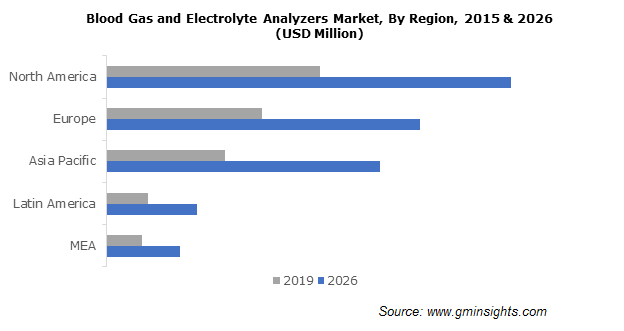Blood gas and electrolyte analyzers market to register significant profits via escalating demand from point-of-care settings, global industry valuation to exceed USD 5 billion by 2024
Publisher : Fractovia | Latest Update: 2019-03-05 | Published Date : 2017-02-10Request Sample
The expansion of blood gas and electrolyte analyzers market is a standing proof to the effects that advancements in technology can have on the improvement of the healthcare sector. Blood gas and electrolyte analysis been established as a significant critical care diagnostic tool in case of pre-hospital and in-hospital emergency therapy. Blood gas and electrolyte analyzers are designed to offer a wide range of functions besides measuring blood oxygen levels, the measurement of which parameters enable physicians in detecting a broad range of life-threatening acid-base imbalances and respiratory disturbances. The blood gas and electrolyte analyzers market is expanding as the timely and exact diagnosis of such conditions allows for efficient, properly directed therapy.
U.S. Blood Gas and Electrolyte Analyzers Market, By Product, 2017 & 2024 (USD Million)

From the historic point of view the first functioning blood gas analyzer was launched in the market in 1958 and it was a large, stationary instrument. Shortly after being launched, the medical world perceived the importance of such an instrument and the blood gas analyzers market players started to manufacture instruments that are not only more efficient but also more portable machines that can be widely used in clinical settings, anesthesia surgery and intensive care. From that point, with the advancement of technology, blood gas and electrolyte analyzers have come a long way and recently engineers in the US and the UK developed a flexible sensor for mapping blood-oxygen levels in tissues, over large skin areas and organs that can potentially provide doctors a new way to monitor wound healing in real time.
As the machines have become more portable and the science behind their operations have become more advanced, blood gas and electrolyte analyzers have come to be present in most hospitals, diagnostics centers and have penetrated even the point-of-care segment. For instance, the Radiometer America Inc developed the ABL90 Flex which is a blood gas analyzer is designed to provide laboratory quality blood gas results at the point-of-care for 17 parameters in 35 seconds at the patient’s bedside, including blood gas, oximetry, and electrolytes. It should be prudent to mention here that the blood gas & electrolyte analyzers market amassed a revenue of $1.4 bn from point-of-care settings in 2017 and thanks to technologies like the ABL90 Flex, it is expected to grow rapidly over the coming years to cater to an increasing demand of instantaneous results in the healthcare sector.
The rising incidence of chronic disorders like diabetes, cancer and other cardio vascular diseases will also act as one of the driving factors for the blood gas and electrolyte analyzers market. In 2001, the World Health Organization estimated that 60% of the 56.5 million reported deaths in the world were due to chronic diseases and it also contributed to 46% of the global burden of disease. This proportion is expected to rise to 57% by 2020 and almost half of the chronic disease deaths can be traced back to cardiovascular diseases. Diabetes and obesity are also worrying experts in healthcare not only because they are affecting a large proportion of the population, but also because they have started to appear earlier in life. While clinical technologies and lifestyle changes continue to evolve to arrest such alarming rate of chronic disease, the blood gas and electrolyte analyzers market is expanding rapidly as such tools are becoming indispensable in the diagnosis of such disorders.
In the supposed future scenario of the healthcare industry, where all departments of care are being asked to do more with less, the blood gas and electrolyte analyzers market is also evolving to enable the technology to be more self-monitoring and require little staff intervention. Such qualities are becoming apparent in the next generation of instruments that are being developed now. According to experts, respiratory therapists play a critical role is determining the patient care and blood analysis lies at the core of care management. As such if the critical role is to be maintained, partnership between commercial and clinical becomes crucial. As the innovators and developers participating in the blood gas and electrolyte analyzers market become more capable in maintaining this role, blood gas analyzers are undergoing technological advancements.
For instance, the U.S. FDA recently in 2019 granted clearance to the MediPines Gas Exchange Monitor that is an advanced blood gas analyzer designed to monitor a variety of respiratory parameters and indices of patients presenting with lung conditions. Healthcare industry acquisitions like the acquisition of Epocal Inc., which us the developed of the epoc Blood Analysis System, by Siemens Healthineers was a major move for the blood gas and electrolyte analyzers market in 2017. Besides new developments in technology, mergers and acquisitions will also help in the growth of the blood gas and electrolyte analyzers market, which is expected to surpass $5 billion by 2024.